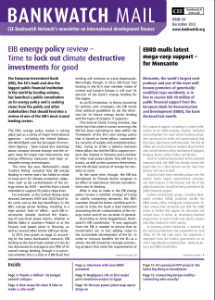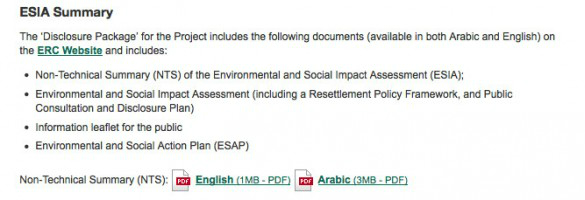IFI negligence rife at first major post-revolution project in Egypt

Bankwatch Mail | 14 December 2012
A USD 3.7 billion PPP oil refinery expansion in Cairo is accompanied by contradictory project documents, making a mockery of claims by the public banks involved to be committed to ‘good governance’ or democracy. Despite being presented as merely translations of one document, the Arabic and English ‘versions’ are entirely different – with the Arabic markedly cursory and superficial.

This article is from Issue 54 of our quarterly newsletter Bankwatch Mail
Browse all articles on the right
This article, written by the activist Mika Minio–Paluello (@mikaminio), was first published on the PLATFORM website.
Egypt’s largest refinery – squeezed between the densely-populated Shobra, Mostorod and Ain Shams districts – is to be enlarged. The public-private mega-project brings together every type of banker in Egypt: Mubarak-regime era financiers at EFG-Hermes, slick Citadel private equity investors based out of the Four Seasons Hotel, public banks like the European Bank for Reconstruction and Development (EBRD)and western high-street banks like HSBC.
While the bankers made their deals, nearby residents in Mostorod and Shobra vehemently opposedvehemently opposed the refinery extension due to pollution, diversion of water sources and planned evictions – demanding that it be moved to an uninhabited area.
Examining the impact assessments for the project, the Egyptian Initiative for Personal Rights (EIPR) was highly alarmed to discover that what is presented by the public banks as the the Arabic language (pdf) “Non-Technical Summary of an Environmental & Social Impact Assessment”, is in reality merely a public relations document. It is not a translation of the English non-Technical Summary (pdf), but a much more superficial project overview, lacking even basic maps of the refinery.
The discrepancies extend into the details. The English document has a section on “Resettlement/ Rehousing” examining the resettlement of 107 individuals and the economic displacement of informal workers who will lose their livelihoods. In contrast, the Arabic ‘version’ makes no mention of resettlement at all – bar one paragraph denying the “removal of any houses or structures outside the complex”.

The two documents on the EBRD’s website – presented as merely different translations
The inferiority of the Arabic materials reveals a level of laziness, as well as a lack of commitment to communicating with the poor communities of Shobra and Mostorod crowded tight around the refinery. It begs the question of how any feasible consultation is possible, when local residents are provided with PR materials that say “look how great this project is” – not with real assessments based on due diligence.
Reem Labib of EIPR explained that “In effect, ERC [Egyptian Refining Company] has failed to supply an Arabic ESIA. If the EBRD goes ahead with funding the Mostorod refinery, this will make a mockery of the bank’s rhetoric of development, best practice and improving governance, by rewarding a dangerous combination of lazy documentation and forced displacement.”
The EBRD is currently considering a USD 40 million loan to the refinery mega-project. It plans to join other financial institutions including Citadel Capital, EFG Hermes, the World Bank’s IFC and the European Investment Bank (EIB). The impact assessments were disclosed by the EBRD on 17 October and the board is scheduled to make its decision on December 18.
International finance institutions have been expanding their operations in Egypt since the revolution started in January 2011. This is despite repeated calls by social movements to stay away, with civil society pointing to the contradiction between their neoliberal intentions to privatise and deregulate, and the revolutionary mobilisation which has social justice at its core.
The EBRD – initially created in the 1990s to expand market economies across post-Socialist Eastern Europe – is in the process of expanding its mandate so that it can lend to corporations in Egypt, Tunisia, Morocco and Jordan.
While the bank presents its role as supporting democracy and improving governance, the fact that it has chosen the Mostorod refinery as its first project target in Egypt betrays its true intentions. Producing impact assessments in the language of the local community is not essential. Irrelevant are some of the highly controversial existing shareholders: USD 462 million of equity was provided by the private equity fund EFG Hermes, which is embroiled in corruption allegations involving Gamal Mubarak.
Presumably bank officials also didn’t consider the public opposition. Reports have been circulating in Cairo of many people being evicted for the construction work and not being satisfactorily rehoused. Concerns over air pollution causing lung cancer and asthma led to local public opposition. The company is also set to consume an enormous amount of water from the Nile and the Ismailia Canal. Processed water will apparently be pumped back into the Canal – raising fears over the impacts on fish and cattle. Hence the popular campaign called for the refinery expansion to be moved to uninhabited areas.

Excerpt from the ERC website – claiming that a Non-Technical Summary of the ESIA “is available in both Arabic and English Languages”
The impact assessments in question were not produced by the public banks. This is the responsibility of the operating company – the Egyptian Refining Company and the project management company – WorleyParsons. The banks then examine the documents, to see whether they meet their lending criteria, and upload them to their website so that stakeholders can submit comments or responses. Somehow the IFI staff monitoring the project documentation either didn’t notice or weren’t bothered with the contradictions between the English and Arabic documents.
Production of the Environmental and Social Impact Assessments was outsourced to the Welsh Huckbody Environmental Ltd. The documents were then scrutinised by ERM, contractors working for the EIB. ERM have a controversial history, including producing some of the highly flawed impact assessments for BP’s Baku-Tbilisi-Ceyhan pipeline. One village was supposedly consulted despite the residents all having fled fighting, while another – still present – was erased from project maps and documents.
The refinery is widely known as the “Citadel Refinery”, and Ahmed Heikal’s private equity firm based in the Four Seasons on the Corniche has sourced the USD 3.7 billion for the expansion. Shareholders in the refinery include Qatar Petroleum (27.9%), Egypt General Petroleum (23.8%), Citadel Capital (11.7%) and the Inframed Fund (7.5% – itself controversially owned by EFG Hermes and the EIB).
‘Development’ lenders also bought stakes: the World Bank’s IFC (6.4%), the Dutch FMO (2.2%) and Germany’s DEG (2.0%). Other financiers include the African Development Bank and the Japanese and Korean Export Credit Agencies. HSBC, Credit Agricole, CIB, Bank of Tokyo-Mitsubishi and Sumitomo were also involved.
Theme: Energy & climate | Social & economic impacts
Location: Egypt
Tags: BW Mail 54
Never miss an update
We expose the risks of international public finance and bring critical updates from the ground. We believe that the billions of public money should work for people and the environment.
STAY INFORMED
